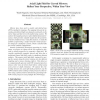Free Online Productivity Tools
i2Speak
i2Symbol
i2OCR
iTex2Img
iWeb2Print
iWeb2Shot
i2Type
iPdf2Split
iPdf2Merge
i2Bopomofo
i2Arabic
i2Style
i2Image
i2PDF
iLatex2Rtf
Sci2ools
CVPR
2010
IEEE
2010
IEEE
Axial light field for curved mirrors: Reflect your perspective, widen your view
Mirrors have been used to enable wide field-of-view (FOV) catadioptric imaging. The mapping between the incoming and reflected light rays depends non-linearly on the mirror shape and has been well-studied using caustics. We analyze this mapping using two-plane light field parameterization, which provides valuable insight into the geometric structure of reflected rays. Using this analysis, we study the problem of generating a single-viewpoint virtual perspective image for catadioptric systems, which is unachievable for several common configurations. Instead of minimizing distortions appearing in a single image, we propose to capture all the rays required to generate a virtual perspective by capturing a light field. We consider rotationally symmetric mirrors and show that a traditional planar light field results in significant aliasing artifacts. We propose axial light field, captured by moving the camera along the mirror rotation axis, for efficient sampling and to remove aliasing arti...
| Added | 10 Feb 2011 |
| Updated | 10 Feb 2011 |
| Type | Journal |
| Year | 2010 |
| Where | CVPR |
| Authors | Yuichi Taguchi, Amit K. Agrawal, Srikumar Ramalingam, Ashok Veeraraghavan |
Comments (0)

